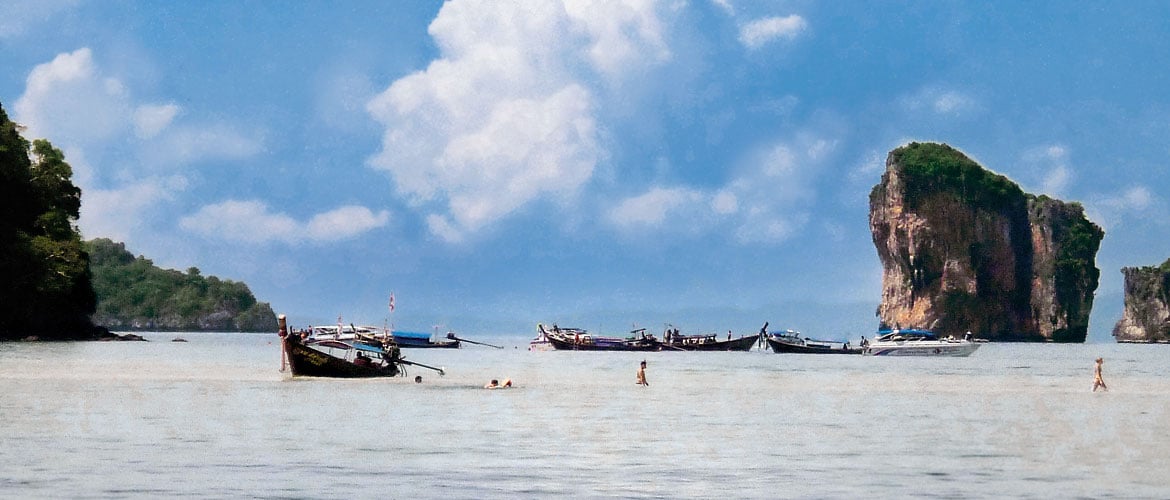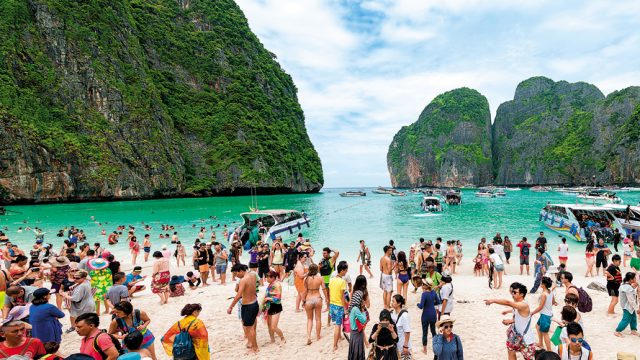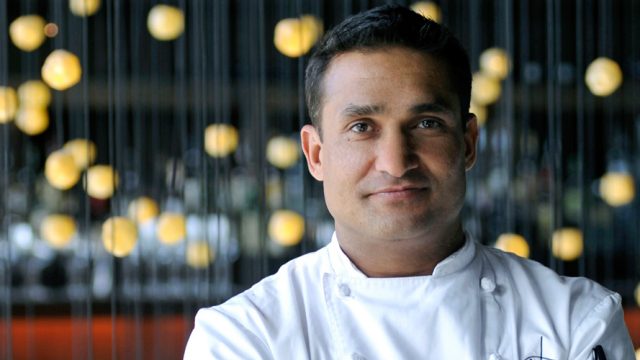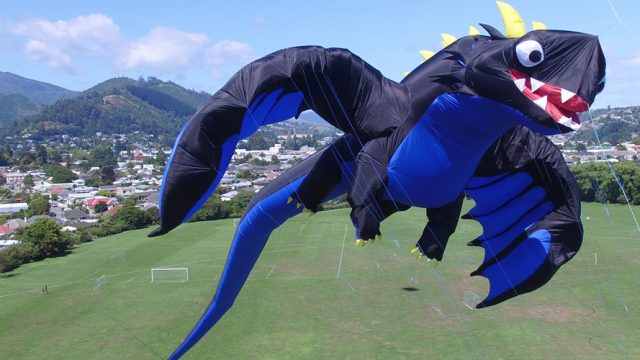Amazing Thailand says the tourism tagline. And why not? From natural attractions to built architecture, from traditional

If you are travelling in the next couple of months, please remember the nation is officially in a year-long mourning following the demise of King Rama IX, who died on 13 Oct 2016 having reigned for 70 years. Mourning is nationwide but particularly evident in Bangkok, with Thai citizens dressed compulsorily in black and white, government and other building under drapes, etc. However, normal tourist activities are not barred and foreigners are not expected to follow the dress-code. But if you do, people appreciate it. The late king’s cremation will take place on October 26, 2017; expect disruption in regular activities and transportation.
Getting There
The most popular airports for entering Thailand are Suvarnabhumi Airport of Bangkok and the Phuket International Airport. Besides, there are international services to and from Chiang Mai, Krabi, Ko Samui, and Hat Yai. Thailand is also connected by road, rail and ferry with its neighbouring countries. If you are willing to splurge, you may ride the luxurious Eastern & Oriental Express train (https://www.belmond.com/eastern-and-oriental-express/), which travels between Bangkok, Singapore and Malaysia.

Various Indian and foreign airlines fly directly from India to Bangkok. For example, there are direct flights from Bengaluru, Chennai, Guwahati, Hyderabad, Jaipur, Kochi, Kolkata, Mumbai and New Delhi. However, depending on demand, sometimes these flights may be withdrawn or rerouted. So do check before planning. Some of the airlines flying between India and Bangkok are Air India, Jet Airways, Indigo, SpiceJet, Thai, etc. Air Asia flies directly between Kolkata and Don Mueang Airport. Refer to www.skyscanner.co.in for a comprehensive list of flights.
Thailand issues 60-day Tourist Visa (single and multiple entry). In India, Thai visas are available from The Royal Thai Embassy in Delhi and the Royal Thai Consulate General offices in Kolkata and Chennai, and six other centres in India. Indian passport holders visiting Thailand for tourism can avail the Visa on Arrival facility in Bangkok. But it is valid only upto 30 days. You may also be asked to show proof of living expenses for 30 days.

What to See and Do
Bangkok, on the Chao Phraya River, may overwhelm you at first sight. But do not panic. Start with the Rattanakosin area or ‘old Bangkok’, taking your time around the Grand Palace, Wat Pho, etc. North of Rattanakosin is Khao San Road (a typical backpacker country) and to the south lies Thonburi, a relatively quiet area compared to the rest of the city. Take a look at the Wat Arun here, enjoy a canal tour and explore the floating market. Another interesting part is the Siam Square bordered by Sukhumvit to its east. A commercial zone, Siam Square is home to several shopping malls. Sukhumvit Road is known for its restaurants and nightlife.
With Bangkok as your base, it is easy to explore central and eastern Thailand.

Ayutthaya, about 85km from Bangkok, is located at the confluence of three rivers — Chao Phraya, Lopburi and Pa Sak. Founded around 1350, it was the second capital and an important trading post of Siam. However, the city lost much of its grand buildings when an attacking Burmese army in 1767 razed the city to the grounds. In 1991, the city was recognised as a World Heritage Site by UNESCO. Most of the ruins of temples and monasteries lie in the north-western corner of the island. Kanchanaburi, at the confluence of the rivers Kwai Noi and Kwai Yai, shot to global fame with Bridge on the River Kwai, one of the bridges along the Death Railway of Second World War. The city preserves memories of WWII through its sites and museums. Although most of old Kanchanaburi lie ruins, a number of Buddhist temple still exist, including the Wat Pa Lelai, best known for the giant Buddha statue receiving alms from an elephant and a monkey. Nearly 65 km by road from Kanchanaburi is the seven-level Erawan Waterfalls. The second level of the fall forms a pool ideal for swimming. Trekkers can go up to the upper levels.
Although visited in tandem with Bangkok, Pattaya (150km from the capital) is way too commercialised, and sleazy. The beach front is crowded with hotels, restaurants and shopping malls. At night, the street south of Beach Road turns into Walking Street and a hotspot of diverse activities.

Most of the popular beaches of Thailand are strung along the southern part. Despite its commercialisation, Phuket remains the biggest draw, easy air access being one of the main reasons. Public transport is a convenient way to get around Thailand’s largest island. A radial network of ‘songthew’ (converted pick-up trucks that serve as a bus) connects the town with the beaches, which lie on the west coast (a place that was badly hit during the 2004 tsunami). Some of the popular beaches include Patong (known for its nightlife), Karon, Bang Thao, Kata, Mai Kho, etc. Ya Noi offers good snorkelling opportunities. Chalong Bay is a popular diving site. These days many sites are offering ‘snuba’ (snorkelling + scuba) diving for amateurs. You use the same equipment as in scuba diving (fins, masks, weights, regulators) but instead of carrying the air tank on your back, you breathe from a long hose from tanks fixed on surface pontoon rafts. Professional dive guides accompany ‘snuba’ diving groups. Ko Samui is another popular island known for its beaches (such as Chaweng, Lamai, Bophut, Bang Rak, etc) and diving points. From here, you can visit Mango Bay, located in Koh Tao, surrounded by small beaches, turquoise water and coral reefs. This bay is often used for scuba diving on a beginner level due to its flat and sandy seafloor. The best travel mode to get there is by boat. The Krabi Province is also known for its varied natural attractions, including caves and waterfalls, besides beaches and coral reefs. One of the most striking features here are the massive limestone karsts, rising high on land and water. The crystal clear water off Krabi beaches offer excellent diving opportunities. Located about 40km from Krabi (and Phuket), are the picturesque Phi Phi Islands, where the Hollywood film, ‘The Beach’ featuring Leonardo Di Caprio was shot. Also nearby is the spectacular Lanta Island.

Chiang Mai, with an international airport, in northern Thailand, is the most convenient gateway to this mountainous region. The capital of the ancient Lanna kingdom, it still offers a window to the past through its city wall, the moat and temples. The temples reflect a mix of Lanna Thai, Burmese and Sri Lankan influence and are known for their wood carvings. About 60km from Chiang Mai is the Elephant Jungle Sanctuary, an ethically run eco-tourism project. Chiang Rai, Thailand’s northernmost province lies in the Kok River basin, with the Mekong River on the north and shared boundaries with Laos and Myanmar. Besides enjoying the mountains and valleys, the province offers a closer look at the lifestyle of the local hill tribes. It is best to use the services of a certified guide to venture into the tribal villages. Some offer night stays. However, be careful of private agents who exploit the tribes to extract money from unsuspecting tourists. One of the most popular trips in northern Thailand is a three-day round trip from Chiang Mai, which covers Doi Ang Khang, Fang, Thaton, Doi Mae Salong, Mae Sai, and Golden Triangle. Sukhothai, in lower northern Thailand, the first capital of Thailand, is a UNESCO World Heritage Site. Bangkok Airways operates direct flights between Bangkok and Sukhothai. The ancient ruins lie within the Sukhothai Historical Park, divided into multiple zones (each with its own ticketed entry). If you are not able to explore the entire 70 sq km park, then you may concentrate on the Central Zone.

Where to Eat and Drink
Even though Thai cuisine has made a name for itself globally, once in Thailand you will realise it is only the tip of the iceberg. Once in Thailand, you will be amazed by the regional varieties. From lip-smacking street food to a gourmet dinner cooked by a royal chef, you will be spoilt for choice. Bangkok is the mecca for local and global cuisine. North of the Grand Palace, Khao San Road is backpacker country. Explore the pocket-friendly bars and restaurants or sample traditional Thai dishes from the food trucks. Bangkok’s Chinatown, locally known as Yaowarat, is lined with food trucks selling Chinese dishes, from fried noodles to iced Chinese dessert, in the evening. Although floating markets in and around Bangkok are known to sell everything, their food boats are no less exciting. You may opt for a dinner cruise along the Chao Phraya River.
While the cuisine of southern Thailand has some Malaysian influence, that from the north reveals Burmese and Chinese influence. Being on the coast, southern Thailand offers a range of seafood dishes. Curries include Penang (Malaysia) curry and Massaman (Indian) curry. When in Chiang Mai, do not forget to sample Khao soi, a Burmese-style dish, consisting of thick coconut curry soup topped with fried noodles.
Where to Stay
There is no dearth of accommodation in Thailand. From international brands to local guest houses, there is something for every budget. For the budget accommodation, it is advisable to look at the rooms before renting. Veteran travellers also advise that in case of cheap accommodation, let the boarding or guest house owner or manager put down on paper the room rate agreed upon to avoid problems later. It is common to bargain for rates if you are visiting in the off season or staying for a long vacation. Homestays can be found in rural areas but do not expect anything fancy. A word of caution, many hotels and guest houses use anti-bed bug sprays, where use of illegal toxic chemicals have allegedly led to the death of guests. So, do check with the hotel/guesthouse/homestay about their pesticide use.
Bangkok
Pattaya
Phuket





